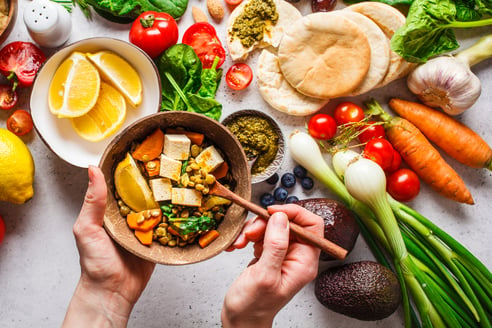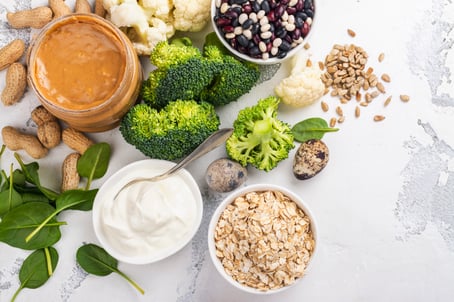 A few years ago, I made it my New Year’s Resolution to completely cut out animal products from my diet. I had played around with a couple variations of diets for a few years in college while competing in a Division 1 rowing program—cutting out all red meat, processed meats, and chicken, and only eating fish. Essentially the only things left were the eggs, milk, and cheese. I had been hesitant because cheese was my absolute favorite thing to add to every meal. I dreamed about doing a cheese and wine tour of Europe one day—I was really in love with cheese.
A few years ago, I made it my New Year’s Resolution to completely cut out animal products from my diet. I had played around with a couple variations of diets for a few years in college while competing in a Division 1 rowing program—cutting out all red meat, processed meats, and chicken, and only eating fish. Essentially the only things left were the eggs, milk, and cheese. I had been hesitant because cheese was my absolute favorite thing to add to every meal. I dreamed about doing a cheese and wine tour of Europe one day—I was really in love with cheese.
Why and How I Did It
My motivation to go completely animal product–free stemmed from the obvious health benefits that I was learning about so quickly as I finished up my degree to become a dietitian. But it also was influenced heavily by my love for the planet (plant-based diets have an extremely low carbon footprint) and all animals (even the ones that most people consider to be food and not pets).
As you already know, the transition was very slow… over several years. I didn’t go from steak, cheesy potatoes, and a side of green beans with bacon to a full-on Buddha Bowl tofu smoothie overnight! I also researched and talked to fellow dietitians as I made the switch to make sure I was taking the appropriate steps to ensure a healthy transition as well (please don’t hesitate to reach out).
My Top Tips for Transitioning to a Plant-Based Diet
For those who are considering going plant-based, here are my tips that I’ve learned throughout the years.
Start with One Meal at a Time
Pick just one meal a day to make mostly plant-based—don’t worry about the rest of your meals and snacks yet. Instead of a fried egg and bacon breakfast sandwich, replace your bacon and egg with your favorite greens, caramelized onion, sautéed peppers, etc.
Make Your Favorite Meal Plant-based
Do you love spaghetti and meatballs and eat it multiple times a week or a couple of times a month? This is the meal to focus on! Spaghetti and the red sauce are fine as is. Now you just need to find a delicious “meatball” recipe that uses things like beans and lentils and spices and freeze some to save time for the next meal. Pizza can be delicious on its own without cheese, but you can consider adding dairy-free cheese.
Find Your Favorite Brand of Store-bought Dairy-free Cheese
My favorites… and I’ve tried them all!
- VioLife Feta Cheese (delicious on a cheese board with apple slices)
- SoDelicious Cheddar (good for pizzas)
- Miyokos (Whole Foods carries wheels of this delicious brand)
- TreeLine (small tubs of herbed cheeses that are delicious on crackers)
- Daiya Pepper Jack cheese block
There are dozens more, and many folks try making their own cheese, but if you can find just one, this makes the transition 100 times easier.
Be Prepared for Restaurants
This might mean expanding your palate and trying new places. Indian, Thai, and Ethiopian are prime examples of cuisines that highlight plant foods over animal foods. But even our favorite fast-food chains have vegan options:
- Chipotle offers sofritas (tofu).
- Burger King and White Castle offer Impossible Meat Burgers (remember, moderation is still key).
- Noble Roman’s offers vegan cheese on pizzas.
As “vegan” continues to be rather trendy, the options are endless. Don’t be afraid to create your own dish and ask for substitutions or leave things off the dish. The Happy Cow app lists vegan options all over the city.
Be Open-minded
Change is hard, especially when it comes to food. Food is something we have a strong connection to. We associate different meals with happiness, sadness, a certain holiday, or a family favorite that has been a go-to every Monday night. My family did our first entirely vegan Thanksgiving two years ago. Despite the fact that the entire immediate family had gone vegan a few years ago, many of our extended family members were not on board with this move. Expose friends, family, and new acquaintances to some of your new favorite dishes at various gatherings and you just might end up with another buddy to swap recipes with!
This blog was written by Lindsey Hehman, MA, RD, CD. To learn more about the NIFS bloggers, click here.


 Mondays can be hard enough, getting back into the swing of things after a much-too-short weekend. The last thought on your mind is what to cook for dinner, right? You might go out to eat instead, pick up carryout, or eat a frozen pizza for the most painless dinner prep possible. However, what if you opt for something that is not only easy for you, but also healthy for you and the planet?
Mondays can be hard enough, getting back into the swing of things after a much-too-short weekend. The last thought on your mind is what to cook for dinner, right? You might go out to eat instead, pick up carryout, or eat a frozen pizza for the most painless dinner prep possible. However, what if you opt for something that is not only easy for you, but also healthy for you and the planet?
 Vegans
Vegans